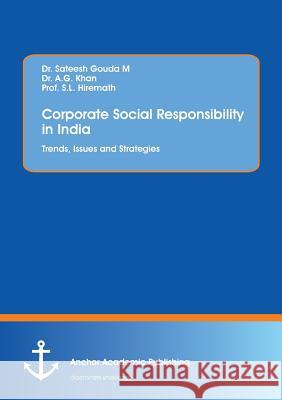Corporate Social Responsibility in India. Trends, Issues and Strategies » książka
Corporate Social Responsibility in India. Trends, Issues and Strategies
ISBN-13: 9783960671077 / Angielski / Miękka / 2017 / 280 str.
Corporate Social Responsibility (CSR) - the commitment of organizations to balance financial performance with contributions to the quality of life of their employees, the local community and society at large - is gaining worldwide value as a business tool and social effort. The review of literature suggests that many studies have been undertaken globally to understand CSR as a subject of management but there have been very few studies undertaken to understand the other dimension of CSR which is beneficiary (community) aspect of CSR, especially in India. Here, the authors make an attempt to understand the CSR concept from both the dimensions of CSR i.e. management and beneficiaries of CSR (community). The authors try to understand the issues covered by the management and their implementing strategies in order to meet community needs. Also, the authors try to study the requirements and satisfaction of the community in the area where the corporates implement CSR. This type of attempt is the first one in India to study the community awareness and ist knowledge about CSR as well as the organisations working in the community. The present study also tries to measure the impact of CSR activities undertaken by the organizations in a way to have the sustainable development at village level. In this context, the present study plays a significant role in the field of Research Methodology, the field of management as well as social science, especially from the social work perspective. To meet the study objectives, both primary and secondary data were used. The primary data was collected in Karnataka, India by selecting nine organisations, three of each from Govt., Private and Multinational companies; those were recognised as leaders in implementing CSR activities. To understand the impact of CSR on community, 450 community respondents were also interviewed with the help of structured questionnaire. Secondary data for the study was obtained from Karmayog. CSR Ratings of the 500 l
Corporate Social Responsibility (CSR) - the commitment of organizations to balance financial performance with contributions to the quality of life of their employees, the local community and society at large - is gaining worldwide value as a business tool and social effort. The review of literature suggests that many studies have been undertaken globally to understand CSR as a subject of management but there have been very few studies undertaken to understand the other dimension of CSR which is beneficiary (community) aspect of CSR, especially in India. Here, the authors make an attempt to understand the CSR concept from both the dimensions of CSR i.e. management and beneficiaries of CSR (community). The authors try to understand the issues covered by the management and their implementing strategies in order to meet community needs. Also, the authors try to study the requirements and satisfaction of the community in the area where the corporates implement CSR.This type of attempt is the first one in India to study the community awareness and ist knowledge about CSR as well as the organisations working in the community. The present study also tries to measure the impact of CSR activities undertaken by the organizations in a way to have the sustainable development at village level. In this context, the present study plays a significant role in the field of Research Methodology, the field of management as well as social science, especially from the social work perspective. To meet the study objectives, both primary and secondary data were used. The primary data was collected in Karnataka, India by selecting nine organisations, three of each from Govt., Private and Multinational companies; those were recognised as leaders in implementing CSR activities. To understand the impact of CSR on community, 450 community respondents were also interviewed with the help of structured questionnaire. Secondary data for the study was obtained from Karmayog. CSR Ratings of the 500 largest Indian companies and other similar studies, other available articles, books, companies' annual reports and related publications were reviewed in the study.











